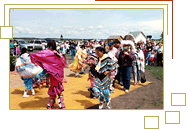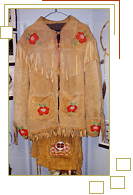|
 |
The First Nations
 The
first people to live in this great country were the
Native peoples. Long before the first Europeans came
to Canada, the Native people were hunting and fishing
as needed for food, clothing or shelter. This is true
also of the peoples of the Moose Lake area. The abundant
fish and fur-bearing animals of the region filled most
of their needs. The
first people to live in this great country were the
Native peoples. Long before the first Europeans came
to Canada, the Native people were hunting and fishing
as needed for food, clothing or shelter. This is true
also of the peoples of the Moose Lake area. The abundant
fish and fur-bearing animals of the region filled most
of their needs.
When the fur trade reached this part of Canada, the
natives would trade furs that they had caught for various
items – whiskey, tobacco, and other needed objects.
The Northwest Trading Company had a presence in the
Moose Lake area as early as 1789, when Angus Shaw, a
fur trader for the company, built a cabin on the shore
of Moose Lake. He lived there for three years, trapping
furs and trading with the natives. The Hudson Bay Company
soon had an outpost here as well.
About ninety years later, in 1870, the native and Métis communities suffered a terrible tragedy. A smallpox epidemic struck that fall, which "swept the country" and wiped out whole families...[and] villages in its wake." Fortunately, the community was not hit so hard by the Great Famine which struck two years later in 1872.
 In
the last years of the nineteenth century, the natives
met with an official from the Department of Indian Affairs
who advised them to move to a reservation of their own.
(At that time, plans were underway to create a reserve
with the dimensions of 9 X 4 miles.) Two elders who
had been appointed to speak for the native community
"scoffed at the idea of being tied down to a cupful
of their own land. They refused to heed the warning
that the Moose Lake district would soon all be filled
with Whites." A few years later in 1904, the Kehewin
Reserve was created, and the natives were required to
relocate. The originally planned dimensions (9 X 4 miles)
were changed to 6 X 6 miles. Three years later, the
first settlers arrived. In
the last years of the nineteenth century, the natives
met with an official from the Department of Indian Affairs
who advised them to move to a reservation of their own.
(At that time, plans were underway to create a reserve
with the dimensions of 9 X 4 miles.) Two elders who
had been appointed to speak for the native community
"scoffed at the idea of being tied down to a cupful
of their own land. They refused to heed the warning
that the Moose Lake district would soon all be filled
with Whites." A few years later in 1904, the Kehewin
Reserve was created, and the natives were required to
relocate. The originally planned dimensions (9 X 4 miles)
were changed to 6 X 6 miles. Three years later, the
first settlers arrived.
(Information taken from Echoes of the Past – A Short History of Moose Lake in 1907, by J. E. Dion)
Native Art
The native peoples have a very rich and vibrant culture, expressed through their artwork, song, and dance. The beaded clothing and jewellery is one example of their artwork; the drum and traditional costume, other cultural artifacts, suggest their use at Powwows or other community gatherings. All the artifacts in this exhibit testify to the artistry and ingenuity of Canada's native peoples.
The Legend of the Dream Catcher
Legend tells us that the Dream Catcher was used by the Woodland Cree Indians and was hung in the sleeping area of the dwelling place near the window. Its use was to catch all dreams, good or bad. The bad dreams would get caught up in the webbing and be held there until the first morning light, then burned off. Now, the good dreams were caught, and knowing their way to the whole in the center, would filter down into the feathers and be held there, only to return another night to be dreamed again.
|
|
 |
|